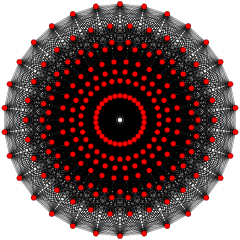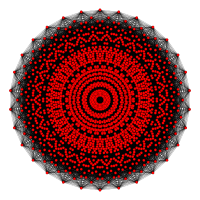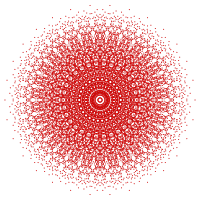Eight-dimensional space
In mathematics, a sequence of n real numbers can be understood as a location in n-dimensional space. When n = 8, the set of all such locations is called 8-dimensional space. Often such spaces are studied as vector spaces, without any notion of distance. Eight-dimensional Euclidean space is eight-dimensional space equipped with a Euclidean metric, which is defined by the dot product.
More generally the term may refer to an eight-dimensional vector space over any field, such as an eight-dimensional complex vector space, which has 16 real dimensions. It may also refer to an eight-dimensional manifold such as an 8-sphere, or a variety of other geometric constructions.
Geometry
8-polytope
A polytope in eight dimensions is called an 8-polytope. The most studied are the regular polytopes, of which there are only three in eight dimensions: the 8-simplex, 8-cube, and 8-orthoplex. A broader family are the uniform 8-polytopes, constructed from fundamental symmetry domains of reflection, each domain defined by a Coxeter group. Each uniform polytope is defined by a ringed Coxeter-Dynkin diagram. The 8-demicube is a unique polytope from the D8 family, and 421, 241, and 142 polytopes from the E8 family.
| A8 | B8 | D8 | |||||||||
|---|---|---|---|---|---|---|---|---|---|---|---|
 8-simplex |
 8-cube |
 8-orthoplex |
 8-demicube | ||||||||
| E8 | |||||||||||
 421 |
 241 |
 142 | |||||||||
7-sphere
The 7-sphere or hypersphere in eight dimensions is the seven-dimensional surface equidistant from a point, e.g. the origin. It has symbol S7, with formal definition for the 7-sphere with radius r of
The volume of the space bounded by this 7-sphere is
which is 4.05871 × r8, or 0.01585 of the 8-cube that contains the 7-sphere.
Kissing number problem
The kissing number problem has been solved in eight dimensions, thanks to the existence of the 421 polytope and its associated lattice. The kissing number in eight dimensions is 240.
Octonions
The octonions are a normed division algebra over the real numbers, the largest such algebra. Mathematically they can be specified by 8-tuplets of real numbers, so form an 8-dimensional vector space over the reals, with addition of vectors being the addition in the algebra. A normed algebra is one with a product that satisfies
for all x and y in the algebra. A normed division algebra additionally must be finite-dimensional, and have the property that every non-zero vector has a unique multiplicative inverse. Hurwitz's theorem prohibits such a structure from existing in dimensions other than 1, 2, 4, or 8.
Biquaternions
The complexified quaternions , or "biquaternions," are an eight-dimensional algebra dating to William Rowan Hamilton's work in the 1850s. This algebra is equivalent (that is, isomorphic) to the Clifford algebra and the Pauli algebra. It has also been proposed as a practical or pedagogical tool for doing calculations in special relativity, and in that context goes by the name Algebra of physical space (not to be confused with the Spacetime algebra, which is 16-dimensional.)
References
- H.S.M. Coxeter:
- H.S.M. Coxeter, Regular Polytopes, 3rd Edition, Dover New York, 1973
- Kaleidoscopes: Selected Writings of H.S.M. Coxeter, edited by F. Arthur Sherk, Peter McMullen, Anthony C. Thompson, Asia Ivic Weiss, Wiley-Interscience Publication, 1995, ISBN 978-0-471-01003-6 Wiley::Kaleidoscopes: Selected Writings of H.S.M. Coxeter
- (Paper 22) H.S.M. Coxeter, Regular and Semi Regular Polytopes I, [Math. Zeit. 46 (1940) 380-407, MR 2,10]
- (Paper 23) H.S.M. Coxeter, Regular and Semi-Regular Polytopes II, [Math. Zeit. 188 (1985) 559-591]
- (Paper 24) H.S.M. Coxeter, Regular and Semi-Regular Polytopes III, [Math. Zeit. 200 (1988) 3-45]
- Table of the Highest Kissing Numbers Presently Known maintained by Gabriele Nebe and Neil Sloane (lower bounds)
- Conway, John Horton; Smith, Derek A. (2003), On Quaternions and Octonions: Their Geometry, Arithmetic, and Symmetry, A. K. Peters, Ltd., ISBN 1-56881-134-9. (Review).
- Duplij, Steven; Siegel, Warren; Bagger, Jonathan, eds. (2005), Concise Encyclopedia of Supersymmetry And Noncommutative Structures in Mathematics and Physics, Berlin, New York: Springer, ISBN 978-1-4020-1338-6 (Second printing)
